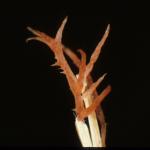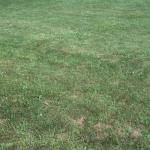Red Thread and Pink Patch
Red thread caused by Laetisaria fuciformis and pink patch caused by Limonomyces roseipellis often occur together. Pink patch was once considered to be a form of red thread due to similarities in symptoms, disease cycle, epidemiology, host range, and appearance. Both diseases occur slow-growing turf caused by low fertility, lack of sunlight, drought, other diseases or plant growth regulators.
These diseases occur on bentgrass, Kentucky and annual bluegrass, perennial ryegrass, and fine-leaf fescue. Red thread and pink patch are favored by cool, wet weather, heavy dews, fog, low fertility, and tend to occur in the spring and fall. Both pathogens are limited to the plant foliage and individual blades die from the tips down. Dead leaves become mixed with healthy leaves which give the turf an overall diffuse, scorched, and ragged appearance similar to drought stress.
Symptoms of pink patch and red thread appear as roughly circular, pinkish red to tan patches, 2-4 in. in diameter. The red thread pathogen produces pink to pale red or orange, thread-like sclerotia which can be seen with the naked eye on infected leaves. In dry conditions, the sclerotia become brittle, are easily detached, and may be spread by equipment or fall into the thatch where they remain viable for up to two years. Under wet conditions, pink, cottony flocks of mycelium and arthroconidia may be produced. Pink patch spreads much more slowly than red thread, is less severe, and does not produce sclerotia or cottony flocks of mycelium. Individual leaves become covered with a pink, gelatinous mycelium which can survive for long periods in plant debris.
L. fuciformis survives unfavorable periods as sclerotia, in infected debris, or in the thatch. Reproductive structures are spread by water, wind, equipment, and people. They require a film of moisture on leaves for germination and infection. The pathogen is capable of growth over a wide range of temperatures. L. roseipellis survives as mycelium in plant debris and is also capable of growth at a wide range of temperatures. It has a slow rate of growth and generally causes greater damage to low maintenance turf.
Cultural Management
- Maintain adequate and complete fertility (potassium, phosphorus, calcium as well as nitrogen) as determined by soil tests.
- An application of water-soluble nitrogen reduces disease severity and is generally the only treatment needed in residential lawns.
- Maintain soil pH between 6.0 and 6.5.
- Water deeply and infrequently while preventing moisture stress.
- Avoid late afternoon, evening, and light, frequent irrigations which extend periods of leaf wetness.
- Prune trees and shrubs to improve air circulation and increase light penetration.
- Keep mower blades to sharp to minimize leaf wounding which can enhance infection.
- Collect grass clippings when the disease is active or turf is growing slowly to reduce the number of sclerotia that are incorporated into the thatch.
Management with Fungicides
Fungicide applications are seldom necessary for management of red thread and pink patch, especially in residential settings.
For a listing of fungicides currently labeled to manage these pathogens, refer to our current fungicide charts or the latest edition of the Professional Guide for IPM in Turf for Massachusetts.
--
Written by: M. Bess Dicklow
Revised: 08/2011

